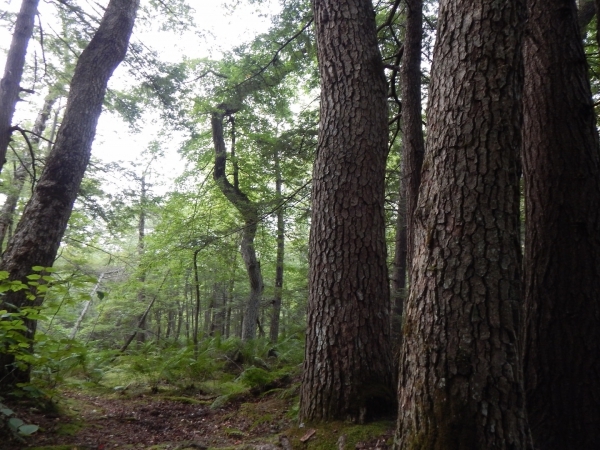VERNON — With its thick layer of peat, drooping ferns, and twisted black gum trees purported to be hundreds of years old, some say walking into Vernon's Black Gum Swamp is like taking a trip back in time.
State officials want to make sure it stays that way.
The Vermont Department of Environmental Conservation is laying the groundwork for making Black Gum Swamp a “Class 1” wetland, giving it the most stringent preservation and protection standards available. Only three other wetlands in the state carry that label.
The designation has earned support from Vernon town officials, who already had enacted a plan limiting vehicle access and discouraging logging in the vicinity of the swamp and its rare trees.
“We believe that the Black Gum Swamp is exceptional and irreplaceable in its contribution to Vermont's natural heritage and therefore merits the highest level of protection,” Vernon Selectboard members wrote in a recent letter to the state.
A 'wetland complex'
Black Gum Swamp is actually a series of swampy areas described by the state as a “wetland complex” covering a combined 41 acres. It lies mostly within the J. Maynard Miller Town Forest, though some of the swamp also is situated within the adjacent, state-maintained Roaring Brook Wildlife Management Area.
Advocates for protecting the area offer a long list of attributes: The forest floor, featuring moss and peat that's been measured 11 feet deep in spots, boasts at least five rare, threatened, and endangered plants and two uncommon plant species.
The swamp hosts at least 54 species of birds, according to the Department of Environmental Conservation's Watershed Management Division. It's also home to multiple species of amphibians and three species of bat, and it provides habitat suitable for beaver, black bear, and wood duck.
Officials also tout the site's floodwater-storage and erosion-control capacities.
The swamp's crown jewels, however, are its black gum trees. While not uncommon in more-southern climes, black gums are rare this far north; their presence in Vernon is “a remnant from the past, when the climate was warmer - approximately 3,000 to 5,000 years ago,” state officials say.
In this part of the country, “they're really, really rare,” said Lynn Levine, a Dummerston-based forester and educator. “That whole concept - just the rareness of it is incredible.”
“There's no question that there's educational value in looking at a tree that's so different from other trees,” Levine added.
Town and state documents assert some of the swamp's black gums are more than 400 years old. That speaks both to the rarity of the trees and also to the fact that Black Gum Swamp has gone largely untouched in recent history.
A delicate ecosystem
Vernon's town plan, though, makes note of the swamp's fragility. The document imagines several scenarios that could harm the site's prized trees, including severe winters or windstorms; logging or off-road vehicle activity; and even overuse by “well-meaning visitors.”
The plan offers provisions for “preventing sudden environmental changes around the swamps,” including limiting vehicle access. Vernon officials also encourage sound forest management practices and “shall discourage any tree-cutting within a 300-foot radius of the swamp,” the plan says.
Laura Lapierre, who manages the state's Wetlands Program, said Vernon residents “have been really great stewards for these wetlands.”
Now, state officials want to take that stewardship to a new level by applying the Class 1 wetland designation. State documents supporting the change sum up the site's ecological value this way: “The function and values the Vernon Black Gum Swamp provides would be difficult or impossible to restore should impacts to it occur.”
Recreational uses like Vernon's town-maintained trails in the area wouldn't be affected by the new label. But Class 1 protection would mean a wider barrier for potentially harmful activities, including any sort of development or land modification.
“For this wetland, we're looking at a 300-foot buffer zone,” Lapierre said. “Currently, these wetlands are considered Class 2 and have a 50-foot buffer zone.”
Discouraging development
Theoretically, permits are available for development that would affect a Class 1 wetland or its buffer. But documents say such a project would be unlikely, since the state issues such permits only “to meet a compelling public need to support public health or safety.”
“It's a really high bar,” Lapierre said.
Failing to heed state wetland protections could get expensive. The state can levy a fine of up to $42,500 for the first violation of an environmental regulation, then can tack on an additional $17,000 per day for continuing violations.
The state's maximum fine doesn't rise for a Class 1 wetland. But officials say they consider a violation's “degree of detriment” when determining fines, so a violation in a Class 1 area might be deemed more detrimental and worthy of a stiffer penalty.
If Black Gum Swamp receives a Class 1 label, it would join three other such wetlands in Vermont. They are Dorset Marsh in Bennington County, North Shore Wetland in Chittenden County, and Tinmouth Channel Wetland in Rutland County.
But changing the Vernon property's status could take some time. The process involves contacting landowners and other affected parties; filing for a rule change; and setting up a public comment period.
Though the Vermont Wetlands Program can propose the change, it's ultimately up to the state Legislature to approve it.
